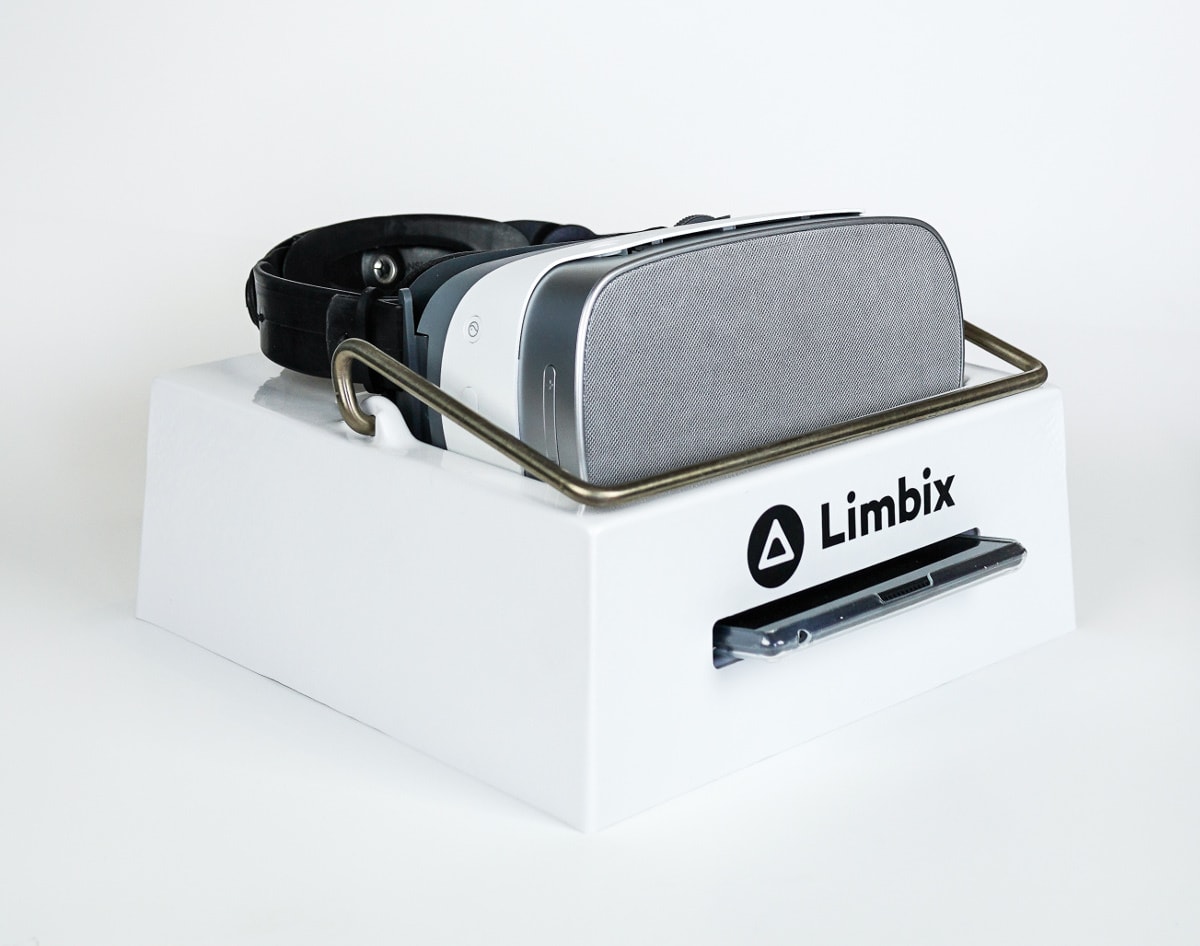Virtual reality helps to cope with mental disorders
- Transfer
Limbix creates content with the effect of total immersion, which psychotherapists can use to work on overcoming phobias, depression and anxiety disorder.

More than 300 peer-reviewed studies have shown that BP (virtual reality) is an effective tool in the treatment of such mental disorders as anxiety, depression, trauma, and dependence. It is therefore not surprising that there are many companies that are developing therapeutic content that uses immersive technology. This is a promising field of activity: from helping passengers relieve tension during long flights to virtual AI psychotherapists .
One such company, Limbix , has teamed up with experts for collaborative research and creates content for psychotherapists that can be applied in a wide variety of treatments: exposure therapies, non-judgmental awareness, experiential learning, and skills development.

To date, the company has attracted $ 3 million of initial investment, mainly from venture capital firm Sequoia Capital. Amazingly, the company located in Palo Alto [note: not far from San Francisco, USA] managed to establish contacts with a number of well-known organizations and experts to lead the process of creating content in the right direction and fixing the effectiveness of virtual worlds that they seek to create.
“After a year of research and interviews, we were not only convinced that there was interest in BP, but also learned that the technology can support therapy and patient care in other ways,” says researcher Eliz Ogle. Last year, she became the team leader for projects in Limbix, and before that she worked at the Stanford laboratory for human interaction with virtual reality and created virtual worlds, among which is the well-known Becoming Homeless (What is it like being homeless) [for example, more about the experiment in this translation ].
Ogle explains that there are significant problems with the availability of treatment and a sort of label of shame in the sphere of work with mental disorders, which is why people do not receive the necessary help. “BP is an innovative technology that patients can't wait to try. Medical organizations can use this tool to improve patient care, ”she adds.
One example of how all this may look like is a project specializing in the correction of adolescent behavior. The approach in this area changed when Harvard researchers discoveredthat remote psychological assistance [approx .: independent use by the patient of specially designed programs, without direct interaction with a specialist] was very effective in reducing the symptoms of depression.

Researchers at the Harvard Laboratory for Adolescent Mental Health decided to find out whether the intervention of BP would be more effective compared to distance assistance. They decided to develop a virtual program, where in one session of psychological assistance the object learns to apply growth thinking, which has already proved its usefulness in overcoming depression. To this end, the lab has partnered with Limbix and researchers from other organizations, such as the Mood Disorder Laboratory at the University of Texas at Austin and the Stony-Brooke University Customizable Mental State Laboratory.
“The task is to have a virtual program not only to help understand depression and allow adolescents to realize that they are not alone in their struggle, but also to teach them to analyze their feelings and overcome difficulties,” says Ogle, adding that they almost got approval of the medical ethics commission and will begin clinical studies this year.
Another clinical trial, which was scheduled to begin in January, is led by Dr. Bar Taylor from Stanford University and Palo Alto University and Dr. Michel Newman from the University of Pennsylvania. They also intend to use BP in exposure therapy for patients with social anxiety disorder.
“We took into consideration two social scenarios that a person would most likely encounter in real life, and where BP would be useful to him in the treatment of exposure and working out these situations. In the course of the passage of the script, practicing interaction with other people in social situations, they will learn to work on their anxiety, ”Ogle says.
Patients in groups of BP-therapy will follow the scenario drawn up on the basis of their personal “hierarchy of fears”, paving the way for the growing: from insignificant anxiety to what worries them most.
The two first scenarios were a job interview and a party with strangers. For each situation, several scenarios were filmed, which researchers use to build the hierarchy of fears for each patient.

Examples in the first situation include answers to difficult questions in front of various interviewers, participation in a group interview, and one-on-one interview. In the second, the patient needs to attract the attention of a stranger, return food that he did not order, and answer the stranger with standard questions in the process of dating. To facilitate the treatment of a wide range of mental disorders, it is planned to constantly expand the library of virtual world scenarios.
This technology carries not only health benefits, but also represents a significant market opportunity, since it can be implemented in various areas of health care: mental health centers, clinics, centers for combating addiction, and even schools. Limbix has already opened access to the product for customers willing to pay for it, and will use invaluable feedback to guide further development.
About the author. Alice Bonasio - BP-consultant, Tech Trends website editor.
Note from the translator: the phrase "earlier this year" in the paragraph about the work of Elise Ogle translated as "last year", since the article was first published in December 2018, and accordingly "early in the new year" as "this year" .

More than 300 peer-reviewed studies have shown that BP (virtual reality) is an effective tool in the treatment of such mental disorders as anxiety, depression, trauma, and dependence. It is therefore not surprising that there are many companies that are developing therapeutic content that uses immersive technology. This is a promising field of activity: from helping passengers relieve tension during long flights to virtual AI psychotherapists .
One such company, Limbix , has teamed up with experts for collaborative research and creates content for psychotherapists that can be applied in a wide variety of treatments: exposure therapies, non-judgmental awareness, experiential learning, and skills development.

To date, the company has attracted $ 3 million of initial investment, mainly from venture capital firm Sequoia Capital. Amazingly, the company located in Palo Alto [note: not far from San Francisco, USA] managed to establish contacts with a number of well-known organizations and experts to lead the process of creating content in the right direction and fixing the effectiveness of virtual worlds that they seek to create.
“After a year of research and interviews, we were not only convinced that there was interest in BP, but also learned that the technology can support therapy and patient care in other ways,” says researcher Eliz Ogle. Last year, she became the team leader for projects in Limbix, and before that she worked at the Stanford laboratory for human interaction with virtual reality and created virtual worlds, among which is the well-known Becoming Homeless (What is it like being homeless) [for example, more about the experiment in this translation ].
Ogle explains that there are significant problems with the availability of treatment and a sort of label of shame in the sphere of work with mental disorders, which is why people do not receive the necessary help. “BP is an innovative technology that patients can't wait to try. Medical organizations can use this tool to improve patient care, ”she adds.
One example of how all this may look like is a project specializing in the correction of adolescent behavior. The approach in this area changed when Harvard researchers discoveredthat remote psychological assistance [approx .: independent use by the patient of specially designed programs, without direct interaction with a specialist] was very effective in reducing the symptoms of depression.

Researchers at the Harvard Laboratory for Adolescent Mental Health decided to find out whether the intervention of BP would be more effective compared to distance assistance. They decided to develop a virtual program, where in one session of psychological assistance the object learns to apply growth thinking, which has already proved its usefulness in overcoming depression. To this end, the lab has partnered with Limbix and researchers from other organizations, such as the Mood Disorder Laboratory at the University of Texas at Austin and the Stony-Brooke University Customizable Mental State Laboratory.
“The task is to have a virtual program not only to help understand depression and allow adolescents to realize that they are not alone in their struggle, but also to teach them to analyze their feelings and overcome difficulties,” says Ogle, adding that they almost got approval of the medical ethics commission and will begin clinical studies this year.
Another clinical trial, which was scheduled to begin in January, is led by Dr. Bar Taylor from Stanford University and Palo Alto University and Dr. Michel Newman from the University of Pennsylvania. They also intend to use BP in exposure therapy for patients with social anxiety disorder.
“We took into consideration two social scenarios that a person would most likely encounter in real life, and where BP would be useful to him in the treatment of exposure and working out these situations. In the course of the passage of the script, practicing interaction with other people in social situations, they will learn to work on their anxiety, ”Ogle says.
Patients in groups of BP-therapy will follow the scenario drawn up on the basis of their personal “hierarchy of fears”, paving the way for the growing: from insignificant anxiety to what worries them most.
The two first scenarios were a job interview and a party with strangers. For each situation, several scenarios were filmed, which researchers use to build the hierarchy of fears for each patient.

Examples in the first situation include answers to difficult questions in front of various interviewers, participation in a group interview, and one-on-one interview. In the second, the patient needs to attract the attention of a stranger, return food that he did not order, and answer the stranger with standard questions in the process of dating. To facilitate the treatment of a wide range of mental disorders, it is planned to constantly expand the library of virtual world scenarios.
This technology carries not only health benefits, but also represents a significant market opportunity, since it can be implemented in various areas of health care: mental health centers, clinics, centers for combating addiction, and even schools. Limbix has already opened access to the product for customers willing to pay for it, and will use invaluable feedback to guide further development.
About the author. Alice Bonasio - BP-consultant, Tech Trends website editor.
Note from the translator: the phrase "earlier this year" in the paragraph about the work of Elise Ogle translated as "last year", since the article was first published in December 2018, and accordingly "early in the new year" as "this year" .
